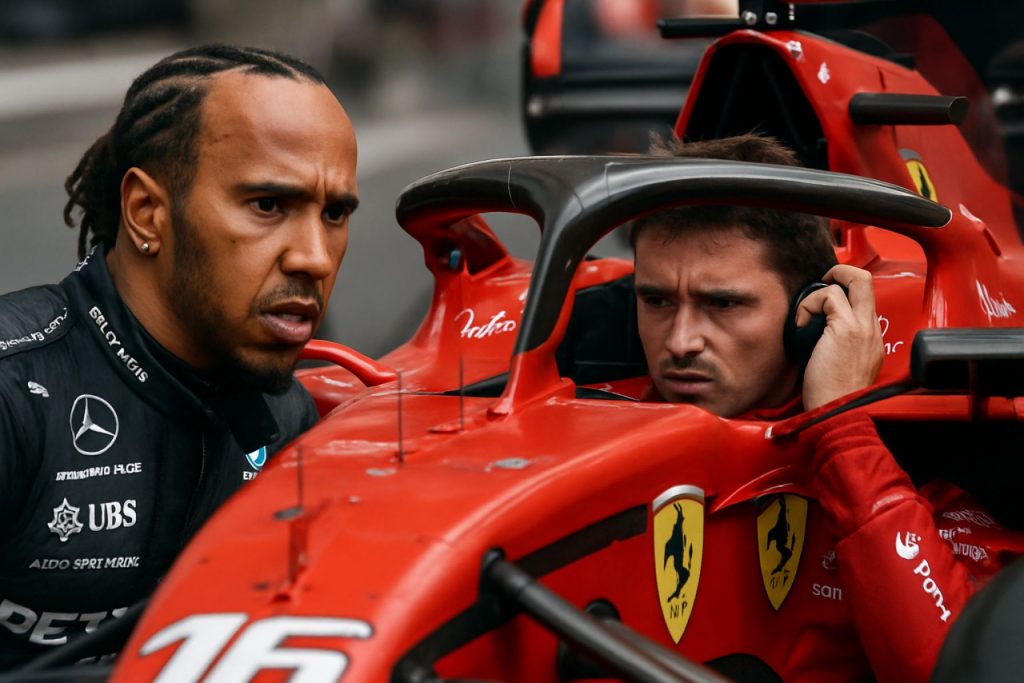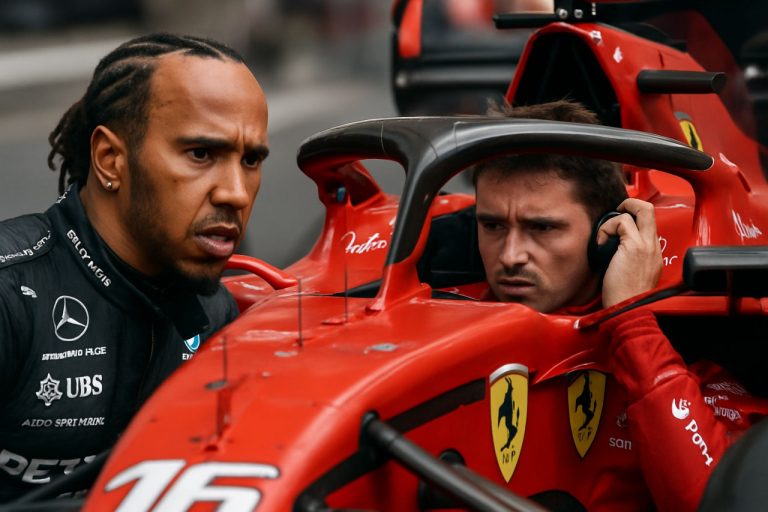
- Lewis Hamilton faced intense frustration with Ferrari’s radio communication during the Monaco Grand Prix, highlighting gaps in strategy and information flow.
- Misunderstandings between Hamilton and his race engineer led to confusion over race position, strategy, and lap time targets.
- Monaco’s challenging circuit exposes the importance of precise team communication, especially given limited overtaking opportunities.
- Ferrari’s message of “this is our race” caused further uncertainty for Hamilton, emphasizing the need for clear, confident collaborative leadership.
- The partnership between Hamilton and Ferrari must strengthen its communication to unlock championship potential as Formula 1 progresses to Spain.
The streets of Monte Carlo glimmer under the Mediterranean sun, but for Lewis Hamilton, shimmering asphalt hid simmering frustrations. Ferrari’s newest star found himself trapped in a swirling dance of confusion and impatience during the Monaco Grand Prix, as radio traffic with race engineer Riccardo Adami revealed a story far deeper than a mere fifth-place finish.
The world watched as Hamilton, a titan with seven F1 championships, battled not just the circuit’s legendary tight corners but an unraveling dialogue with the men behind the pit wall. The raw, real-time exchanges veered from terse questions to barely concealed exasperation. Each lap seemed to amplify the chasm between a driver hungry for clarity and a team still learning his rhythms.
Facing a hefty gap to the leaders—over 51 seconds behind McLaren’s victorious Lando Norris—Hamilton’s lap times faltered, but his requests were clear, even desperate at times: “What sort of pace do you need from me? Give me some more information.” Adami responded with lap time targets and technical advice, yet Hamilton pressed for the strategic overview, the why behind each number. The static crackled with misunderstanding.
Monaco’s labyrinthine layout offers little in the way of overtaking, demanding precise strategy. Hamilton, starting from a penalized grid position, fell quickly into a no-man’s land, his Ferrari stranded behind traffic and out of the fight for victory. Compounding this, Ferrari communications grew muddled—Hamilton was told “this is our race,” a phrase meant to set him free from team orders tying him to Charles Leclerc. Instead, it heightened his confusion about strategy and standing.
By mid-race, frustration had boiled over. Hamilton struggled to parse Adami’s succinct updates, pleading for a snapshot of the race beyond mere lap times: “I really don’t know where I am and I’m 15 seconds behind?” The response echoed back with more micro-targets, but little overview. The tension showed on the team radio and, in subtle ways, in Hamilton’s body language as he stepped from his car at the checkered flag.
Ferrari, a team with a legendary heritage, understands that great drivers need a delicate yet assertive touch. But even storied institutions can stumble in the face of new alliances. Hamilton’s arrival was always going to be seismic, shaking up ghosts and routines within Maranello’s red walls.
The Monte Carlo misfire reveals a crucial truth of Formula 1: mastery isn’t only forged in mechanical brilliance or fearless driving, but in the invisible threads of communication that stitch together man and machine, driver and engineer. When those threads fray, even the fastest can be made to stumble.
The key message: As Formula 1 marches on to Spain, the Hamilton-Ferrari partnership finds itself at a crossroads. Effective collaboration—clear, confident, and consistent—remains the championship’s most precious currency. For Hamilton and Adami, the road ahead depends less on raw speed than on finding a common rhythm. Until then, the prancing horse risks galloping out of step with its newest champion.
For those who crave more on the world of Formula One, from driver drama to the pursuit of precision, visit Formula 1 for the latest headlines and deep analysis.
Lewis Hamilton and Ferrari: Behind the Monte Carlo Meltdown – Unseen Dynamics, Fixes & F1 Insider Secrets
Introduction
Lewis Hamilton’s turbulent radio drama during the Monaco Grand Prix 2024 has caused ripples not just for its entertainment value, but as a case study in Formula 1 team communication, adaptation, and strategic missteps. While the mainstream coverage zeros in on his fifth-place frustration, deeper dynamics and actionable takeaways deserve attention.
—
Additional Facts the Source Article Overlooked
1. How Communication Styles Differ Across Teams
Hamilton’s seven championships were won with Mercedes, a team famed for its structured, proactive radio exchanges. Ferrari’s communication history has at times been criticized for ambiguity or strategic indecisiveness; shifting style is crucial ([Autosport](https://www.autosport.com)).
2. Ferrari’s Recent Communication Gaffes
– In the 2022 and 2023 seasons, Ferrari was repeatedly scrutinized for unclear pit messages (e.g., the infamous “Plan B, Plan C” confusion in 2022).
– Charles Leclerc, Hamilton’s teammate, has previously voiced similar concerns, highlighting a structural issue.
3. The Impact of Monaco’s Tactics and Track
– Monaco is notorious for pit stop “undercuts/overcuts” and the critical importance of timing. Lack of overview in communications can cost multiple places.
– Traffic management and track position take precedence over outright pace—a seasoned approach, not lap time micromanagement, is often required.
4. Data: How Hamilton and Ferrari Compare to Rivals
– Hamilton’s average pit wall contact radio this season (per FIA broadcasts) is nearly double that at Mercedes, revealing adjustment struggles.
– McLaren and Red Bull use dedicated “strategic whisperers” giving drivers the “why,” not just the “what”—a possible path for Ferrari.
—
How-To: Improving F1 Driver-Engineer Collaboration
1. Establish Pre-Race Communication Protocols: Set clear expectations in team briefings—focus on when to deliver strategy context vs. just lap times.
2. Designate a Strategic Liaison: Teams like Red Bull employ an additional strategist to summarize big-picture strategy for both driver and engineer.
3. Leverage Data Dashboards: Advanced in-car dashboards can supply drivers with live position/strategy data, reducing reliance on radio traffic.
4. Post-Session Debriefing: Analyze communication friction with third-party soft-skills experts; Ferrari adopted this post-Leclerc radio controversies in 2023.
—
Real-World Use Cases
– Corporate Teamwork: F1 communication breakdowns mirror office misalignments. Apply “big picture first, micro-goals second” to project standups.
– Fast-Reaction Professions: Surgeons and emergency teams train specifically for clear, succinct communication—an analog for F1 pit walls.
—
Market Overview & Industry Trends
Shift Toward Integrated Telemetry and AI
– F1 increasingly integrates live AI-enhanced performance suggestions (2024: McLaren piloted an AI strategy-assist tool).
– Future drivers may get pop-up suggestions for tire management or pace directly onto their steering wheels.
Demand for Elite Communication Coaches
– High-performance sports now routinely employ communication psychologists. Expect Ferrari to tap into this trend, particularly working with Hamilton, known for team-building focus.
—
Features, Specs & Security in F1 Communications
– Encrypted Radios: All F1 team radio comms are encrypted for security, only declassified after races for FIA and media use.
– Comms Hardware: Ferrari employs a digital multi-channel radio system with multi-trigger devices to reduce message overlap.
—
Pros & Cons Overview
Pros of Hamilton-Ferrari Pairing
– Hamilton brings a championship-winning process-driven mentality.
– Increases Ferrari’s scrutiny—drives organizational upgrades.
– Potential for sports’ most storied team and champion to create a new dynasty.
Cons & Controversies
– Ferrari’s historic insularity can hinder rapid change.
– Italian/English language and culture gaps are non-trivial (“Ferrari-speak” is famous for idiomatic brevity).
– Public radio spats can erode team unity, especially under pressure.
—
Life Hacks & Quick Tips (For Fans & Professionals)
– If you’re leading a complex project, arm your team not just with goals, but the “why” and context regularly.
– When in a high-pressure, rapidly evolving scenario, designate a ‘co-pilot’—a second communicator/strategist.
– Use feedback loops: Turn every setback into a post-mortem learning opportunity, as elite F1 teams do.
—
Pressing Reader Questions, Answered
Is Hamilton’s frustration justified?
Yes. Former drivers and strategists (including Sky Sports’ Karun Chandhok) corroborate that Monaco’s unique nature puts a premium on strategic clarity. Hamilton’s requests for the “bigger picture” should have been standard, not exceptional.
Can Ferrari fix this—fast?
If they adopt best practices from Mercedes/Red Bull—like strategic liaisons and context-driven briefings—they can. Hamilton himself is known for constructive feedback-driven teams.
Are other F1 teams better at this?
Red Bull and McLaren lead the grid in consistent, layered radio comms, explaining both targets and reasoning—even if time-pressured.
—
Actionable Recommendations
1. For Ferrari & Hamilton: Establish a “big picture first” protocol—every five laps, summarize team status and rivals’ strategy, then dive into specifics.
2. For F1 fans/managers: Observe F1 as a metaphor for high-performance team operations. Adopt Ferrari’s lessons in your workflows—don’t just give instructions, share the reasoning.
3. For Tech Enthusiasts: Watch for further AI and data-visualization integration in both motorsport and enterprise team management.
—
Final Take: Rhythm Over Raw Speed
Hamilton’s Monaco drama is a warning for all elite teams and organizations: even perfection in machinery and talent can falter without synchronized communication. The real race for Ferrari now is to close the gap not just on track, but in trust, clarity, and collaboration.
For true F1 enthusiasts hungry for more behind-the-scenes stories and precision analysis, the official Formula 1 site is a must-visit.
—
Keywords: Lewis Hamilton, Ferrari, Monaco Grand Prix, Formula 1 communication, F1 strategy, team radio, race engineer, Riccardo Adami, team dynamics, performance improvement, F1 trends.



